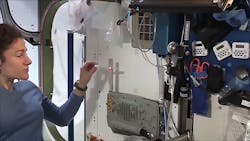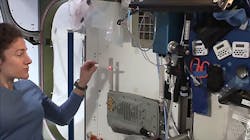Astronauts Test Power Beaming on Space Station
Engineers at the Naval Research Lab developed a light-emitting rectifying antenna, dubbed LEctenna, and coupled it with a modified wireless signal box like those used in homes to emit wireless network signals. The antenna picks up the signal and converts it into small amounts of light and current—a demonstration of power beaming.
NRL had a similar set-up built and sent to the International Space Station. The goal was twofold: It proved the concept of power beaming in space, but the primary goal was as a STEM project to inspire the students. It’s a simple, relatively low-cost design that converts electromagnetic waves to electric power that can be built by students.
“LEctenna was a cool way to raise awareness,” says Elias Wilcoski, an NRL research physicist. “We wanted to show students this is technology they can do themselves. If we can get them excited about it and space solar and power beaming, we can help bring more scientists and engineers into the fields to ensure the viability of our future.”
“Our collaborators at NRL have already begun investigating the wide range of possible applications for this technology,” says Jessica Meir, an astronaut on the space station. “They could find ways to wirelessly charge mobile devices or remotely power drones. But one of the most interesting applications they’re looking into is space-based solar panel arrays.”
Led by electronics engineer Paul Jaffe, NRL researchers are investigating space solar and power beaming as a source of clean energy for a variety of military and civilian applications.
“Some people might know about power beaming, such as for their toothbrush, or putting their phones on a charging pad,” Jaffe says. “What’s really exciting about it though, is that power can be sent wirelessly over much larger distances.”
Space solar is simply using solar panels in space to harvest the sun’s energy, where collecting rays would be unaffected by clouds or other interference. Energy would be beamed down to Earth, at which point it would be converted by a device like LEctenna back into usable energy.

